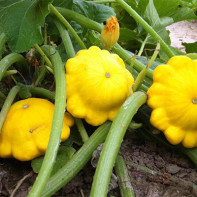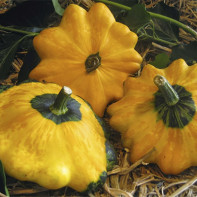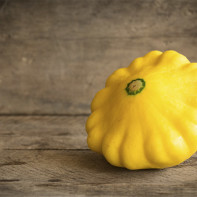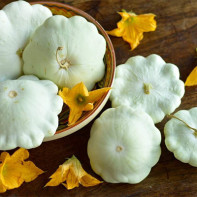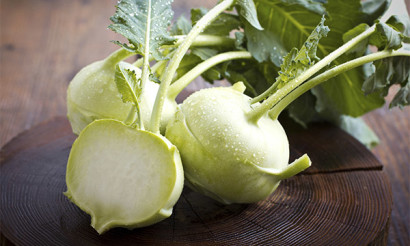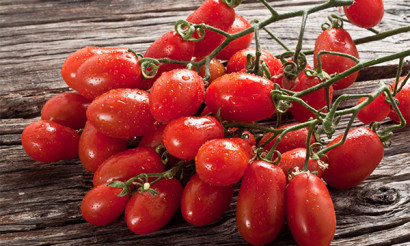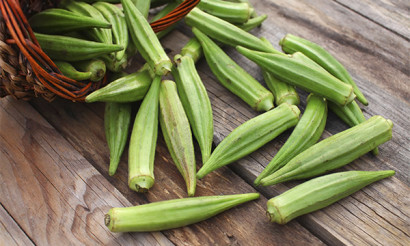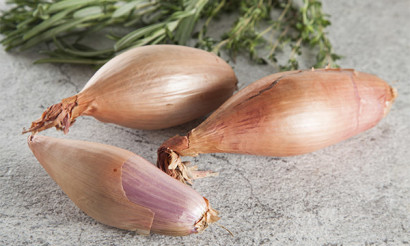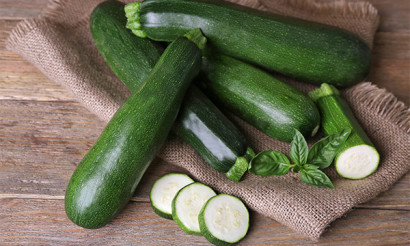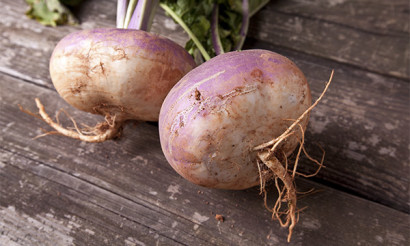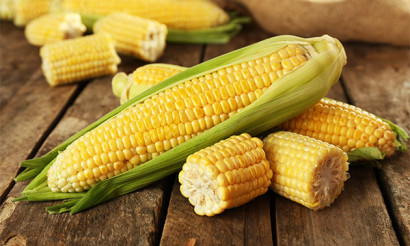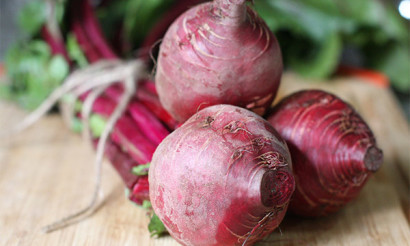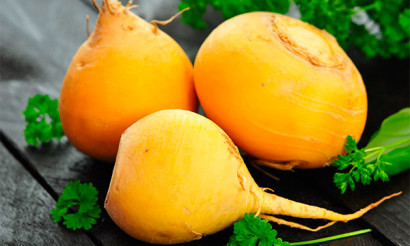Squash: health benefits
How many healthy vegetables there are in the world that even summer residents unjustly forget about. Patisson has been known on our lands for a long time, there are varieties developed by domestic breeders, but nevertheless it has not yet become popular among consumers. And in vain, because this gourd is rich in vitamins and brings many benefits to the body. We will tell you more about these pot-bellied zucchini: how they are valuable for health, when and how to use them and how to cook deliciously.
- What is squash and how does it look
- What is the difference between squash and zucchini
- Composition and calorie content
- Why squash is useful
- General benefit
- For women
- For men
- During pregnancy
- When breastfeeding
- For children
- When losing weight
- Squash in medicine
- Squash in cooking
- Is it possible to fry
- Harm and contraindications
- How to choose and store
- What can be cooked from squash: recipes
- Vegetable cutlets
- Vegetable stew
- "Pots of Gold"
- Interesting facts about squash
What is squash and how does it look
Patisson is an annual gourd plant from the pumpkin family. Its fruits are similar to bells with a skirt, more or less flattened from the poles to the center. To taste, this vegetable resembles a zucchini, a tasteless pumpkin, and it is also compared with artichokes or asparagus.

The plant spreads on the beds, loves moisture and shaded corners, but at the same time needs heat. Its fruits begin to ripen in mid-summer and mature until autumn, but each variety has its own characteristics. Agronomists brought out different subspecies of squash - with small pumpkins that fit in the palm of your hand or large heads the size of a two-liter pan.
Squash can be white - like squash, dark green - like nutmeg pumpkin, yellow-orange - like some types of melon. Striped and mixed varieties are also found. All of them differ slightly in the content of vitamins and minerals, but in general they have common properties and a delicate pleasant taste.
What is the difference between squash and zucchini
- Ripening zucchini is more tender in structure, as a rule, it is difficult to fill them with minced meat and bake in the oven. Whereas more dense pumpkins squash stand such a test steadily.
- Researchers claim that squash contains even more vitamin E than pumpkin and zucchini.
- The smell is different. Each of the melons has its own interesting shade. In squash it is neutral, but slightly more pronounced than in zucchini.
Zucchini and squash are often compared, talking about their culinary equivalence. In addition to the shape of the fruit, there is little that separates them from each other, and lovers of zucchini can appreciate the later autumn vegetable.
Composition and calorie content
In terms of nutrition, squash is a storehouse of vitamins and one of the main diet vegetables. Fresh fruits contain about 90% of water and only 18 kcal per 100 g of pulp. At the same time, the vegetable is rich in vegetable proteins, healthy dietary fiber, mineral salts of potassium, phosphorus, magnesium, calcium, iron, vitamins E and B, in orange copies the content of carotene and ascorbic acid is high.
Doctors say that these pumpkins contain a large concentration of lutein, an important antioxidant, as well as the presence of simple sugars, easily absorbed by the body.
Plant seeds contain valuable polyunsaturated fatty acids and protective substances. Therefore, although they are not eaten during normal cooking, they are dried and ground into powder, which is added to teas and herbal infusions as a laxative and diuretic.
Even after frying in oil, dishes with squash remain dietary and low-calorie, enrich the diet with fiber and useful compounds.
Why squash is useful
General benefit
Juicy vegetable has the following beneficial properties for the body:
- Cleanses the intestines thanks to soft dietary fiber, helps restore peristalsis.
- Lowers blood pressure and supports heart function.
- It removes excess fluid, processed products and salt deposits, helps relieve swelling and improve skin condition.
- Refreshes complexion, saturates the skin with moisture, heals rashes and stops inflammation.
- Promotes the proper functioning of the kidneys and normalizes hormonal balance.
- Removes toxins.
- Eliminates cholesterol deposits, participates in lipid metabolism.
- It acts as a sedative, cools, helps to normalize sleep.
Due to the purity of its composition, this vegetable is safe, it can be safely introduced into baby food, during diet for weight loss, in the menu after illness. The vitamin composition of the vegetable makes it a good nutritional component during fasting and in the diet of vegans. The soft fiber of squash does not irritate the weakened digestive system of the elderly.
Regular consumption of this vegetable in food will help remove accumulated poisons, salts from the body, improve joint function, improve the digestive process, eliminate heartburn, constipation, hemorrhoids, and chronic swelling. Squash and zucchini in the diet help to get tired less and recover faster after working - both mentally and physically.
Pumpkin normalizes the body's water metabolism, helping to easily sweat and remove metabolic products through the skin. This helps to cleanse and accelerate cell metabolism, improve blood supply to tissues, the appearance of a healthy glow, eliminate traces of stress and fatigue. Acceleration of metabolism will improve well-being, lose extra pounds, cleanse the blood.
For women
Fine sex will appreciate the benefits of squash for the skin. A vegetable rich in vitamin E can not only be eaten to improve well-being and lose weight, but also make masks and lotions for face and body from it. They will produce a moisturizing, brightening and peeling effect, contribute to a more even tan, smooth out fine wrinkles and tighten the skin.
The same remedies will eliminate comedones, help get rid of acne, close the pores after cleaning. Also, squash juice will soften the ends of the hair, make them more lively.
Women will appreciate the normalization of digestion due to the use of squash. This will allow you to be less afraid of pampering yourself with sweets, because calories will not be actively stored as fat.
For men
The stronger sex is more prone to heart disease. Squash will help normalize blood pressure, reduce the likelihood of strokes and heart attacks, and stay slim even at an age. The product is rich in vitamins involved in the hormonal balance, this will help maintain fertility and healthy sexual function, less suffer from stress. Squash will help eliminate the symptoms of gastritis, heartburn, normalize the acidity of the body.
During pregnancy
Women in position are often worried about constipation and puffiness, so zucchini and squash are especially useful for them. It is enough to verify the normal functioning of the kidneys and the absence of pumpkin allergies - and you can safely make this vegetable one of the main on the table.
The fruits will help get rid of age spots and other changes on the skin, protect against allergies and strengthen the immune system. Squash components support the health of the nervous system and hormonal stability, help eliminate mood swings.
At the planning stage and at the beginning of pregnancy, a woman will benefit from folates (vitamin B9) as part of the vegetable. They will help prepare the body and form a healthy and developed fetus. Also, vitamin E helps to accelerate cell renewal, increase their elasticity, thanks to this, pregnancy will not spoil the figure.
When breastfeeding
A useful complex of elements in squash improves the quality of milk, removing toxins from a woman's body.As a result, the composition of the mother product becomes cleaner and healthier. Simple sugars - fructose and sucrose - are quickly and easily absorbed by the body, reaching the baby.
It is only necessary to take into account that during lactation the body should not suffer from dehydration. Therefore, diuretics should be avoided, and potassium-rich vegetables should be consumed sparingly.
For children
The child's body needs vitamins for active development, so such a hypoallergenic vegetable will have to be the best. The soft fiber of squash promotes the digestion of babies and does not cause indigestion. Such mashed potatoes can even be boiled in the diet of the smallest children.
In baby food, only preservation with vegetables is forbidden. And to make a child fall in love with a “boring” product, you can cook it with minced meat and cheese, add it to your morning eggs or make aromatic smoothies.
When losing weight
Squash is of great benefit during weight loss diets. The vegetable not only cleanses the intestines and blood, normalizing metabolic processes, but also helps with physical training. The introduction of squash into the diet will help normalize the pH when switching to vegetables and reduce the consumption of unhealthy fats, contribute to the rapid digestion of proteins and sugar, tones, helps the body rebuild to a new regime and maintain harmony.
Squash in medicine
Doctors and nutritionists can advise the use of squash to people with gout and joint diseases to remove heavy salts from the body. The fruit is useful for cleansing the intestines, restoring peristalsis and healthy microflora.
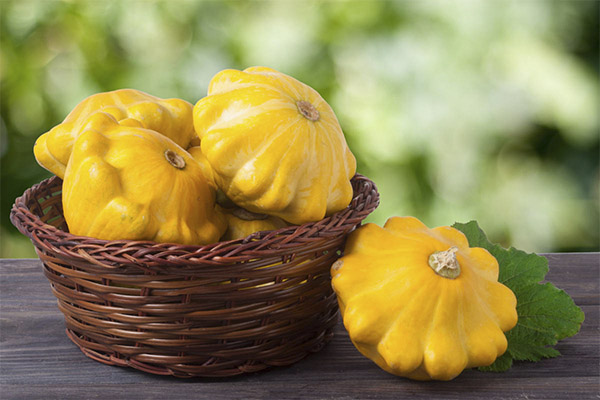
Fresh vegetable in boiled or boiled form will fit well into the menu of diabetics and people with atherosclerosis. Patisson helps to lose weight and remove puffiness, eliminate hemorrhoids. The antiparasitic properties of the plant continue to be studied.
For medicinal purposes, squash is not used, but there are many folk recipes for weight loss based on them. A diuretic and laxative effect is also observed with the introduction of pale pumpkin into the diet, the use of its juice and dried seeds, ground into powder.
Squash in cooking
Plate-shaped pumpkin is a rather convenient and tasty fortified product that can be prepared in many ways. They eat not only fruits, but also shoots and flowers of the plant, but the "pots" themselves are of particular value.
Squash is most often steamed, boiled, used in stews, mashed vegetables, soups and smoothies. You can bake a vegetable or fry it in oil, cream, liquid, in sauces and with spices. Patisson is becoming a valuable source of vitamins for vegetarians and goes well with dairy products, as well as nuts, seeds and cereals.
Like zucchini or cucumbers, squash roll up in banks for the winter. Usually they are pickled whole or chopped. In addition, you can cook sauté, stew or vegetable caviar based on it, which will be an excellent vitamin supplement on the table in the cold season, when fresh vegetables are not available.
Is it possible to fry
To process the delicate flesh of a squash, it is desirable to cook or fry it. Moreover, he, like zucchini, does not lose its basic nutritional and beneficial properties, acquiring a pleasant shade of taste.
Harm and contraindications
Squash is a generally safe vegetable that rarely causes an allergic reaction or unpleasant symptoms. But excessive consumption can provoke some disorders - diarrhea, flatulence, rapid urination and even dehydration. The product is not recommended for people suffering from chronic dyspepsia.
Canned squash can not be given to children, marinades with sugar - for diabetics. Also, the vegetable is not recommended for people with kidney failure and urolithiasis.
How to choose and store
Experts and gardeners recommend choosing young, not overripe squash, when they accumulate a maximum of valuable substances, and the flesh retains its fresh juice. Therefore, when choosing a product to buy, preference should be given to medium and small fruits with ponytails - they do not allow squash to dry out from the inside. The crust should be tender, but whole, without dubious spots and growths. Squash in its composition is closer to zucchini and cucumbers, therefore, in a cut form, like a pumpkin, they are not sold.
For growing on your own plot, it is better to pay attention to miniature yellow varieties - they are both more useful and more practical in processing, and their taste will be more intense and interesting.
Store squash in a vegetable vase at low temperatures. Thanks to the coarse crust, they can lie down for some time in the cellar, but they will not survive the wintering, so the rest of the crop is rolled up for the winter. The product can be salted or pickled in its entirety (miniature fruits) or cooked from it fried vegetable salads with tomato paste.
What can be cooked from squash: recipes
Many refuse to buy squash, because they do not know how to cook them. This penny affordable vegetable is not only easy to process, but also gives tasty and very pleasant dishes to the table.
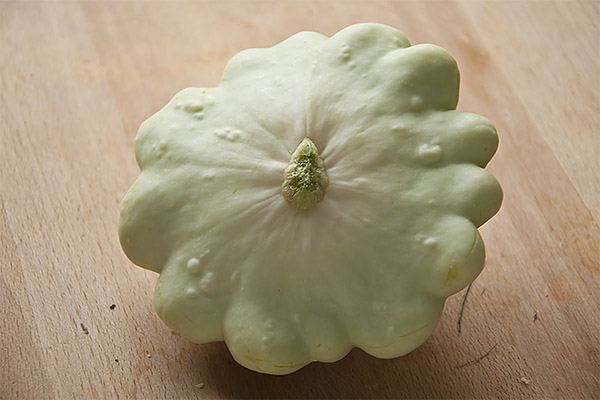
Large pumpkins are most conveniently stewed in slices or grind in a meat grinder into caviar. You do not need to cut the peel, wash the vegetable well enough. But if the crust has become thick, like a pumpkin, it is better to remove it. Small "lanterns" can be used as edible pots, stuffing them, as well as peppers or cabbage rolls - meat, rice with fried, vegetables.
Squash is neutral in taste, so it goes well with many other vegetables:
- Tomatoes
- bell pepper;
- eggplant;
- green beans;
- carrots and celery;
- onions, garlic;
- greens, cabbage;
- soy products;
- all types of meat, dairy products;
- vegetable oil, various sauces, herbs and light southern spices.
Important: Patisson goes well with kefir, sour cream, cream, but it is advisable to avoid combining it with regular milk to avoid diarrhea. Any of these combinations can give a laxative effect.
Here are some simple but interesting recipes for all occasions.
Vegetable cutlets
This is a light lean and dietary dish that energizes and promotes well-being. Such cutlets can be offered to children all year round.
Ingredients:
- 1 tbsp. oatmeal (instant cooking);
- 2 onions;
- 2 cloves of garlic;
- 350-400 g squash;
- 1 carrot;
- celery root - 50–80 g;
- salt, black pepper, coriander or other spices to taste;
- breadcrumbs or semolina (optional);
- boiled water;
- starch;
- butter or vegetable oil for frying.
Oatmeal is poured with warm water in a bowl and allowed to swell. Raw vegetables are rubbed at this time. All components are mixed with porridge, spices are added and the dough is checked for stickiness. If it turned out to be loose due to vegetables, you can take more cereal or add starch.
Thin cutlets are molded from the resulting mass, if desired, they are rolled in breadcrumbs and fried in oil on both sides until they are browned. You can serve such a dish separately or with meat and other snacks, decorating with greens.
Vegetable stew
You can use two recipes. The first is more suitable for rice, the second - for potatoes or buckwheat.
With beans
Ingredients:
- 300 g of green pods;
- 300 g squash;
- 250 g of onions (preferably red or fragrant) onions;
- 2-3 cloves of garlic;
- salt, vegetable oil.
First, beans and garlic are allowed in a pan, then it is transferred to a stewpan and fry the squash and onions together until a golden crust appears. After that, the vegetables are combined and stewed under a lid with the addition of water or broth for a few more minutes until soft and fully cooked. Serve with parsley and celery.
With eggplant
Ingredients:
- 300 g eggplant;
- 300 g squash;
- 300 g non-acidic tomatoes;
- 1–1.5 onions, garlic - optional;
- basil greens;
- vegetable oil;
- tomato paste - 1 tsp;
- sugar - 0.5 tsp (taste);
- fruit vinegar - 1 tablespoon
All vegetables are cut into small cubes, except for tomatoes. First, the components are fried in oil with the addition of salt. Before the onset of readiness, paste, sugar and chopped tomatoes are introduced, the mixture is admixed, basil leaves are added and the prepared dish is insisted under the lid for 10-15 minutes. Serve warm or cool with vinegar.
"Pots of Gold"
You can bake very tasty stuffed squash, for this you need to choose small fruits. As a filling, you can use rice with vegetables, frying and other vegetarian options, but the classic recipe is with meat.
Ingredients:
- minced meat - 500 g;
- squash - 500 g;
- hard cheese - 150 g;
- cream - 3 tbsp;
- onion - 2 pcs.;
- garlic - 1-2 teeth .;
- Tomatoes - 2-3 pcs.;
- salt, pepper, vegetable oil;
- parsley and other favorite herbs, turmeric.
To begin with, “caps” are cut from the squash and the seeds are cleaned, you can also remove a little pulp from the bottom so that the pots are stable. All suitable leftovers are cut into small cubes together with peeled onions and garlic and the mixture is sent to minced meat (if desired, you can add carrots and hot chili peppers). Fill with salt and pepper.
Separately, prepare a creamy sauce with spices - with turmeric, garlic and herbs. Pumpkins are greased with this dressing and minced meat is laid in them. Diced tomatoes are spread on top, add them.
Prepare a baking sheet, you can spread the foil and grease it with oil. The pots are put on it and they are sent to the oven for 40 minutes preheated to 180 °. 3-4 minutes before cooking, the pots are sprinkled with cheese and allowed to reach.
Serve the dish as an independent second. You can cook it not only in the daily menu, but also for the holiday.
It’s interesting to know: squash becomes an excellent base for cream soups, for example, with potatoes, carrots, peas or tomatoes. You can add nuts and spices to these dishes. And the squash goes well with avocados.
Interesting facts about squash
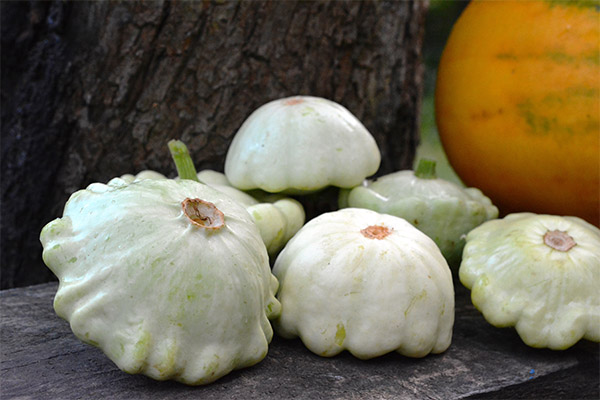
- Like all pumpkin counterparts, squash came to Europe from the American continent. Many centuries ago, the Indians cultivated this unusual vegetable, so that wild species of gourds did not reach us.
- However, it is known that squash was grown in ancient Egypt at a time when the rivers on its territory were full-flowing, and there was enough moisture for active farming.
- The sound was given to the vegetable by the French, it means “pie” because of the similarity of the shape of the fruit with pastries.
Squash is a pleasant enrichment in the diet and enrich the dishes. They are suitable for almost everyone and in moderate portions are not dangerous for well-being. Therefore, it is worth getting to know a useful and affordable vegetable closer.
«Important: all information on the site is provided exclusively in fact-finding purposes. Before applying any recommendations, consult with a profile specialist. Neither the editors nor the authors are liable for any possible harm caused materials. "

